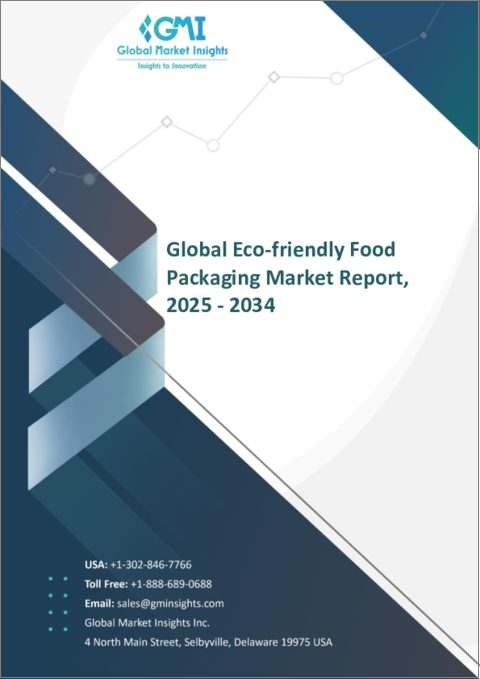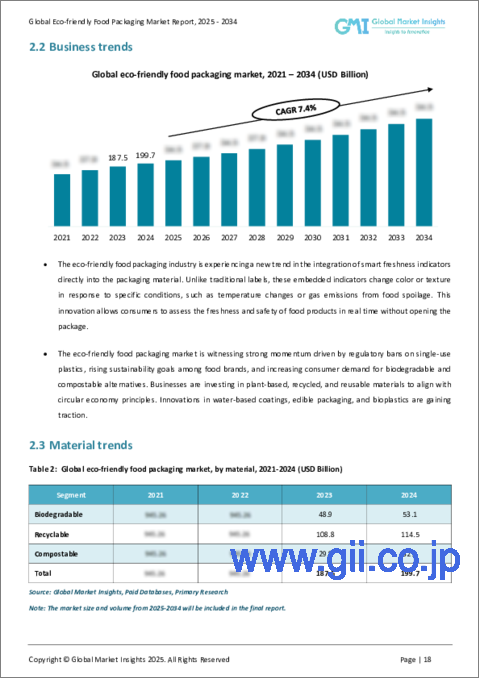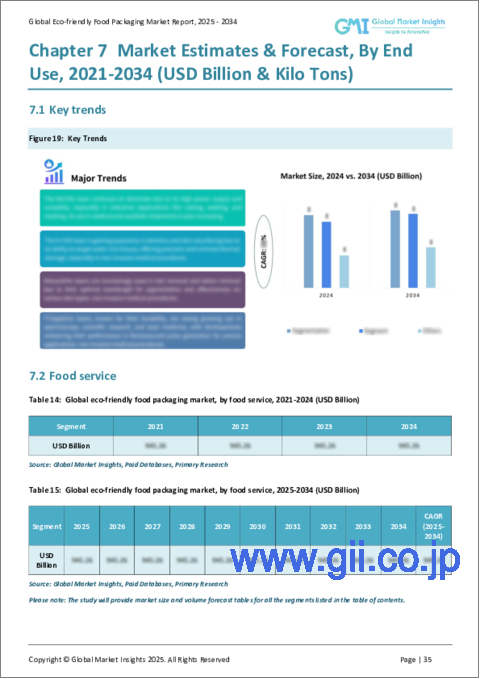|
|
市場調査レポート
商品コード
1685106
エコフレンドリー食品包装の市場機会、成長促進要因、産業動向分析、2025年~2034年予測Eco-friendly Food Packaging Market Opportunity, Growth Drivers, Industry Trend Analysis, and Forecast 2025 - 2034 |
||||||
カスタマイズ可能
|
|||||||
| エコフレンドリー食品包装の市場機会、成長促進要因、産業動向分析、2025年~2034年予測 |
|
出版日: 2025年01月07日
発行: Global Market Insights Inc.
ページ情報: 英文 210 Pages
納期: 2~3営業日
|
全表示
- 概要
- 目次
世界のエコフレンドリー食品包装市場は、2024年に1,997億米ドルに達し、環境持続可能性に対する消費者の意識の高まりと政府の厳しい規制によって、2025年から2034年にかけてCAGR 6.6%で拡大すると予想されています。
消費者は持続可能な代替品を積極的に求めており、ブランドやメーカーは生分解性、堆肥化可能、リサイクル可能なパッケージング・ソリューションへのシフトを促しています。利便性への要求が高まり続ける中、企業は機能性と持続可能性のバランスが取れた革新的なパッケージの開発に注力しています。

材料科学の進歩により、バイオポリマーや植物由来の繊維が登場し、これらは自然に分解されるだけでなく、埋立廃棄物や汚染を削減します。企業はまた、生産と輸送に必要な資源が少なく、二酸化炭素排出量をさらに削減できる、軽量でミニマルなデザインに投資しています。さらに、世界中の規制機関が使い捨てプラスチックに関する政策を強化し、より環境に優しいソリューションを採用するよう業界を後押ししています。持続可能な包装を自社のブランド・アイデンティティに組み込む企業が増えており、市場は長期的な拡大が見込まれています。
| 市場範囲 | |
|---|---|
| 開始年 | 2024 |
| 予測年 | 2025-2034 |
| 開始金額 | 1,997億米ドル |
| 予測金額 | 4,075億米ドル |
| CAGR | 6.6% |
エコフレンドリー食品包装市場は、最終用途別に小売、食品加工、食品サービスに区分されます。2024年は小売セクターが圧倒的で、市場シェア全体の45%を占める。小売業界における持続可能性へのシフトは、環境に配慮した製品を求める消費者の需要に後押しされています。小売業者は、生分解性ラップ、リサイクル可能な容器、余分な廃棄物を最小限に抑えるデザインなど、環境に配慮したパッケージング・ソリューションを優先しています。その結果、大手ブランドは持続可能性の目標に沿い、環境意識の高い買い物客を惹きつけるために、包装戦略を再評価しています。企業はまた、堆肥化可能なフィルムや再利用可能な包装形態といった革新的なパッケージング機能を取り入れ、環境への影響を抑えながら消費者へのアピールを強化しています。
市場はさらに、ボトル・瓶、袋、容器、箱・カートン、その他など製品タイプ別に区分されます。容器分野は最も高い成長を遂げると予測され、CAGRは8%と予想され、2034年には1,330億米ドルに達します。耐久性があり安全な食品包装に対する需要は、様々な業界、特にeコマースや食事の宅配サービスにおいて高まり続けています。改ざん防止シールや積み重ね可能な構造で設計された容器は、安全性と利便性の両方を提供し、人気を集めています。ブランドは、食品保存の完全性を損なうことなく持続可能性を確保するため、軽量でリサイクル可能な素材を採用するようになってきています。さらに、パッケージング技術の先進化により、鮮度インジケーターやQRコードなどのスマートパッケージング機能が導入され、顧客エンゲージメントと透明性が向上しています。
北米は2024年にエコフレンドリー食品包装市場の45%のシェアを占め、米国が地域の需要をリードしています。同国の消費者は持続可能な選択を優先しており、食品包装における生分解性素材やリサイクル素材の採用を促進しています。密封可能なデザインや軽量の包装形態は特に魅力的で、過剰な廃棄を招くことなく利便性を提供しています。企業はまた、トレーサビリティQRコードやデジタル認証機能などのスマート・パッケージング・テクノロジーを活用して、消費者の信頼を高め、持続可能性への取り組みを強化しています。環境に対する関心の高まりと消費者の期待の進化に伴い、北米は持続可能な食品包装イノベーションの主要市場であり続けています。
目次
第1章 調査手法と調査範囲
- 市場範囲と定義
- 基本推定と計算
- 予測計算
- データソース
- 1次データ
- 二次資料
- 有料情報源
- 公的情報源
第2章 エグゼクティブサマリー
第3章 業界洞察
- エコシステム分析
- バリューチェーンに影響を与える要因
- 破壊
- 将来の展望
- メーカー
- 流通業者
- 利益率分析
- 主なニュースと取り組み
- 規制状況
- 影響要因
- 促進要因
- 生分解性および堆肥化可能な包装資材の採用増加。
- 食品サプライチェーンにおけるカーボンフットプリントの削減への関心の高まり
- 水性およびバイオベースの代替コーティング剤の開発
- 持続可能な包装の研究開発への投資の増加
- 廃棄物ゼロの包装ソリューションへのシフト
- 業界の潜在的リスク&課題
- 高い製造コスト
- 環境に優しい材料の入手が困難
- 促進要因
- 成長可能性分析
- ポーター分析
- PESTEL分析
第4章 競合情勢
- イントロダクション
- 企業シェア分析
- 競合のポジショニング・マトリックス
- 戦略展望マトリックス
第5章 市場推計・予測:材料別、2021年~2034年
- 主要動向
- 生分解性
- リサイクル可能
- コンポスタブル
第6章 市場推計・予測:製品タイプ別、2021年~2034年
- 主要動向
- 袋
- 容器
- 箱・カートン
- ボトル・瓶
- その他
第7章 市場推計・予測:最終用途別、2021年~2034年
- 主要動向
- フードサービス
- 小売
- 食品加工
第8章 市場推計・予測:地域別、2021年~2034年
- 主要動向
- 北米
- 米国
- カナダ
- 欧州
- 英国
- ドイツ
- フランス
- イタリア
- スペイン
- ロシア
- アジア太平洋
- 中国
- インド
- 日本
- 韓国
- オーストラリア
- ラテンアメリカ
- ブラジル
- メキシコ
- 中東・アフリカ
- 南アフリカ
- サウジアラビア
- アラブ首長国連邦
第9章 企業プロファイル
- Amcor
- Biomass Packaging
- Biopak
- Eco-Products
- Genpak
- International Paper
- Karl Knauer
- Mondi
- Mpacks
- Nordic Paper
- PacknWood
- Pappco Greenware
- Sealed Air
- Smurfit Kappa
- Sonoco Products
- Stora Enso
- Tetra Pak
- TIPA
- Vegware
- WestRock
The Global Eco-Friendly Food Packaging Market reached USD 199.7 billion in 2024 and is expected to expand at a CAGR of 6.6% between 2025 and 2034, driven by increasing consumer awareness of environmental sustainability and stringent government regulations. Consumers are actively seeking sustainable alternatives, prompting brands and manufacturers to shift toward biodegradable, compostable, and recyclable packaging solutions. As the demand for convenience continues to rise, companies are focusing on developing innovative packaging that balances functionality with sustainability.

Advances in material science have led to the emergence of bio-polymers and plant-based fibers, which not only decompose naturally but also reduce landfill waste and pollution. Businesses are also investing in lightweight and minimalistic designs that require fewer resources to produce and transport, further lowering their carbon footprint. Additionally, regulatory bodies across the globe are enforcing stricter policies on single-use plastics, pushing industries to embrace greener solutions. With an increasing number of companies integrating sustainable packaging into their brand identity, the market is poised for long-term expansion.
| Market Scope | |
|---|---|
| Start Year | 2024 |
| Forecast Year | 2025-2034 |
| Start Value | $199.7 Billion |
| Forecast Value | $407.5 Billion |
| CAGR | 6.6% |
By end-use, the eco-friendly food packaging market is segmented into retail, food processing, and food service. The retail sector dominated in 2024, capturing 45% of the total market share. The shift toward sustainability in the retail industry is being fueled by consumer demand for environmentally responsible products. Retailers are prioritizing eco-conscious packaging solutions, including biodegradable wraps, recyclable containers, and designs that minimize excess waste. As a result, major brands are re-evaluating their packaging strategies to align with sustainability goals and attract environmentally aware shoppers. Companies are also incorporating innovative packaging features such as compostable films and reusable packaging formats to enhance consumer appeal while reducing environmental impact.
The market is further segmented by product type, including bottles and jars, bags, containers, boxes and cartons, and others. The container segment is projected to experience the highest growth, with an anticipated CAGR of 8%, reaching USD 133 billion by 2034. The demand for durable and secure food packaging continues to rise across various industries, particularly in e-commerce and meal delivery services. Containers designed with tamper-evident seals and stackable structures are gaining traction, offering both security and convenience. Brands are increasingly adopting lightweight, recyclable materials to ensure sustainability without compromising the integrity of food storage. Moreover, advancements in packaging technology have led to the introduction of smart packaging features, such as freshness indicators and QR codes, enhancing customer engagement and transparency.
North America held a 45% share of the eco-friendly food packaging market in 2024, with the U.S. leading the regional demand. Consumers in the country are prioritizing sustainable choices, driving the adoption of biodegradable and recycled materials in food packaging. Resealable designs and lightweight packaging formats are particularly appealing, offering convenience without contributing to excessive waste. Companies are also leveraging smart packaging technologies, including traceability QR codes and digital authentication features, to boost consumer trust and enhance sustainability efforts. With growing environmental concerns and evolving consumer expectations, North America remains a key market for sustainable food packaging innovation.
Table of Contents
Chapter 1 Methodology & Scope
- 1.1 Market scope & definitions
- 1.2 Base estimates & calculations
- 1.3 Forecast calculations
- 1.4 Data sources
- 1.4.1 Primary
- 1.4.2 Secondary
- 1.4.2.1 Paid sources
- 1.4.2.2 Public sources
Chapter 2 Executive Summary
- 2.1 Industry synopsis, 2021-2034
Chapter 3 Industry Insights
- 3.1 Industry ecosystem analysis
- 3.1.1 Factor affecting the value chain
- 3.1.2 Disruptions
- 3.1.3 Future outlook
- 3.1.4 Manufacturers
- 3.1.5 Distributors
- 3.2 Profit margin analysis
- 3.3 Key news & initiatives
- 3.4 Regulatory landscape
- 3.5 Impact forces
- 3.5.1 Growth drivers
- 3.5.1.1 Increasing adoption of biodegradable and compostable packaging materials
- 3.5.1.2 Increasing focus on reducing carbon footprint in food supply chain
- 3.5.1.3 Development of water-based and bio-based coating alternatives
- 3.5.1.4 Growing investments in sustainable packaging R&D
- 3.5.1.5 Shift towards zero-waste packaging solutions
- 3.5.2 Industry pitfalls & challenges
- 3.5.2.1 High production costs
- 3.5.2.2 Limited availability of eco-friendly materials
- 3.5.1 Growth drivers
- 3.6 Growth potential analysis
- 3.7 Porter’s analysis
- 3.8 PESTEL analysis
Chapter 4 Competitive Landscape, 2024
- 4.1 Introduction
- 4.2 Company market share analysis
- 4.3 Competitive positioning matrix
- 4.4 Strategic outlook matrix
Chapter 5 Market Estimates & Forecast, By Material, 2021-2034 (USD Billion & Kilo Tons)
- 5.1 Key trends
- 5.2 Biodegradable
- 5.3 Recyclable
- 5.4 Compostable
Chapter 6 Market Estimates & Forecast, By Product Type, 2021-2034 (USD Billion & Kilo Tons)
- 6.1 Key trends
- 6.2 Bags
- 6.3 Containers
- 6.4 Boxes and cartons
- 6.5 Bottles and jars
- 6.6 Others
Chapter 7 Market Estimates & Forecast, By End Use, 2021-2034 (USD Billion & Kilo Tons)
- 7.1 Key trends
- 7.2 Food service
- 7.3 Retail
- 7.4 Food processing
Chapter 8 Market Estimates & Forecast, By Region, 2021-2034 (USD Billion & Kilo Tons)
- 8.1 Key trends
- 8.2 North America
- 8.2.1 U.S.
- 8.2.2 Canada
- 8.3 Europe
- 8.3.1 UK
- 8.3.2 Germany
- 8.3.3 France
- 8.3.4 Italy
- 8.3.5 Spain
- 8.3.6 Russia
- 8.4 Asia Pacific
- 8.4.1 China
- 8.4.2 India
- 8.4.3 Japan
- 8.4.4 South Korea
- 8.4.5 Australia
- 8.5 Latin America
- 8.5.1 Brazil
- 8.5.2 Mexico
- 8.6 MEA
- 8.6.1 South Africa
- 8.6.2 Saudi Arabia
- 8.6.3 UAE
Chapter 9 Company Profiles
- 9.1 Amcor
- 9.2 Biomass Packaging
- 9.3 Biopak
- 9.4 Eco-Products
- 9.5 Genpak
- 9.6 International Paper
- 9.7 Karl Knauer
- 9.8 Mondi
- 9.9 Mpacks
- 9.10 Nordic Paper
- 9.11 PacknWood
- 9.12 Pappco Greenware
- 9.13 Sealed Air
- 9.14 Smurfit Kappa
- 9.15 Sonoco Products
- 9.16 Stora Enso
- 9.17 Tetra Pak
- 9.18 TIPA
- 9.19 Vegware
- 9.20 WestRock





